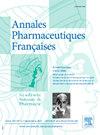Gestion des risques liés à la stérilisation des dispositifs médicaux réutilisables en stomatologie
IF 1.1
Q4 PHARMACOLOGY & PHARMACY
引用次数: 0
Abstract
Objectif
L’objectif de ce travail était d’analyser les risques associés au procédé de stérilisation des dispositifs médicaux réutilisables (DMR) en stomatologie, en appliquant la méthode AMDEC, en vue de mettre en place les actions correctives et préventives nécessaires à la sécurisation de ce procédé.
Méthodes
Il s’agit d’une étude descriptive qui s’est déroulée entre juin et juillet 2024 au service de médecine et de chirurgie dentaire de notre hôpital et concernait le procédé de stérilisation des DMR par chaleur humide. L’étude a commencé par la définition de son périmètre et la formation de l’équipe de travail, ensuite l’analyse fonctionnelle du procédé, l’identification des modes de défaillances (MD), la définition des échelles de cotation, la cotation des MD et finalement le calcul de l’indice de criticité et l’élaboration du plan d’action.
Résultats
Au total, 64 MD ont été identifiés dont 14 de criticité élevée, 16 de criticité moyenne et 34 de faible criticité. L’étape de pré-désinfection et nettoyage était la plus génératrice de défaillances, notamment, celles à criticités élevés. Les MD de criticité élevée ont fait l’objet d’un ensemble d’actions correctives et préventives. Une nouvelle cartographie du procédé de stérilisation mettant en évidence un flux de « marche en avant » a été proposée.
Conclusion
Notre AMDEC a permis de souligner plusieurs MD et de proposer un plan d’actions adéquat. Une deuxième AMDEC serait toujours intéressante pour évaluer la réduction de la criticité globale de notre procédé.
Objective
The aim of this study was to analyze the risks associated with the sterilization process for reusable medical devices (RMD) in stomatology, by applying the FMECA method, with a view to implementing the necessary corrective and preventive actions necessary to secure this process.
Methods
The study, which was descriptive, took place between June and July 2024 in the medicine and dental surgery department of our hospital and concerned the moist heat sterilization process of RMD. The study began by defining its scope and the formation of the work team, followed by the functional analysis of the process, the identification of the failure modes (FM), the definition of the rating scales, the rating of the FM and finally the calculation of the criticality index and the development of the action plan.
Results
A total of 64 FM were identified, including 14 of high criticality, 16 of medium criticality and 34 of low criticality. The pre-disinfection and cleaning stage generated the most failures, particularly those of high criticality. High criticality FM were subject to a set of corrective and preventive actions. A new map of the sterilization process highlighting a ‘forward march’ flow has been proposed.
Conclusion
Our FMECA made it possible to highlight several FM and propose an appropriate action plan. A second FMECA would still be interesting to evaluate the reduction in the overall criticality of our process.
[与牙科中可重复使用医疗器械灭菌有关的风险管理]。
目的:本研究的目的是通过应用FMECA方法分析口腔医学中可重复使用医疗器械(RMD)灭菌过程的相关风险,以期实施必要的纠正和预防措施,以确保该过程的安全。方法:采用描述性研究方法,于2024年6 - 7月在我院内科口腔外科进行,研究内容为RMD的湿热灭菌过程。研究开始于确定其范围和组成工作团队,接着是过程的功能分析,失效模式(FM)的识别,评级量表的定义,FM的评级,最后是临界指数的计算和行动计划的制定。结果:共鉴定出64个FM,其中高临界14个,中等临界16个,低临界34个。消毒前和清洗阶段产生的故障最多,特别是那些高度临界的故障。高临界FM受到一系列纠正和预防措施的约束。提出了一种新的灭菌过程地图,突出了“前进”的流动。结论:我们的FMECA可以突出几个FM并提出适当的行动计划。第二次FMECA对于评估我们流程的总体临界性的降低仍然是有趣的。
本文章由计算机程序翻译,如有差异,请以英文原文为准。
求助全文
约1分钟内获得全文
求助全文
来源期刊

Annales pharmaceutiques francaises
PHARMACOLOGY & PHARMACY-
CiteScore
1.70
自引率
7.70%
发文量
98
期刊介绍:
This journal proposes a scientific information validated and indexed to be informed about the last research works in all the domains interesting the pharmacy. The original works, general reviews, the focusing, the brief notes, subjected by the best academics and the professionals, propose a synthetic approach of the last progress accomplished in the concerned sectors. The thematic Sessions and the – life of the Academy – resume the communications which, presented in front of the national Academy of pharmacy, are in the heart of the current events.
 求助内容:
求助内容: 应助结果提醒方式:
应助结果提醒方式:


